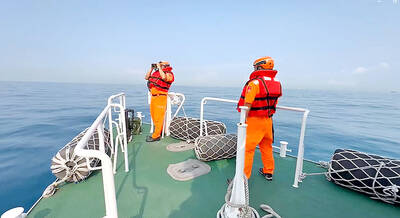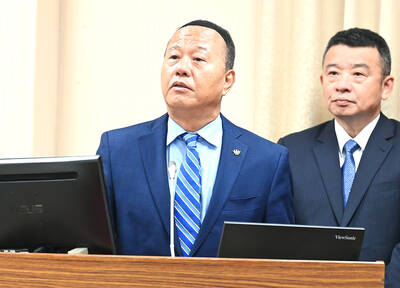After being kept in a warehouse since 2003, the reactor pressure vessel for Unit One of the Fourth Nuclear Power Plant was yesterday finally moved out of storage to be installed on its pedestal.
However, environmentalists expressed concern about the safety of the reactor component. They said that, during a visit last month with Japanese anti-nuclear activists to the plant in Gongliao Township, Taipei County, they noticed that the pressure vessel had started showing signs of rust, which they blamed on lax management.
Meanwhile, the Taiwan Power Company (Taipower) said yesterday that plans for the reactor to go into commercial operation by July next year would be indefinitely delayed.
The 1,007-tonne reactor pressure vessel was completed in 2001 by Babcock-Hitachi, a subcontractor of General Electric. It had been in the warehouse since June, 2003, after it was shipped from Japan. According to Taipower's original plans, construction of the reactor should have been completed by the end of last year.
Lin Yuan-te (林源得), deputy manager for Taipower's Lungmen Construction Office in Gongliao, confirmed yesterday that the vessel was brought to the construction site yesterday.
He said that the pressure vessel would be loaded onto its pedestal on Friday.
Another reactor will be installed in a few years at the power plant, which has a projected total capacity of 2,700MW.
Lin said that as of the end of last month, the plant was about 58 percent complete.
"Progress remains behind the original schedule. The original start-up date for the plant's first reactor, July 2006, will definitely be postponed," he said.
Lin said that the Executive Yuan is still reviewing Taipower's evaluation report on the delay, and that it remains uncertain how long the delay will be.
Meanwhile, anti-nuclear activists were skeptical about the safety of the first reactor owing to the rust that had accumulated on the pressure vessel.
"Before installation, Taipower should explain the massive rust build-up to both residents [of Gongliao Township] and the general public. We'd like to know if it would cause any problem," Lai Wei-chieh (賴偉傑), executive-general of the Green Citizens' Action Alliance, said yesterday.
Lai said that the presence of rust was just one of the examples showing Taipower's lax management with its sub-constructors. In June 2002, it was found that questionable materials were used in the construction of a reactor pedestal for the plant.
Lai said that the designs for the construction, which date to January 1998, should be reviewed and updated.
Lai said that the same type of reactor, an advanced boiling-water reactor (ABWR), was used in a nuclear power plant in Kashiwazaki, Japan, where several nuclear accidents have occurred. Due to persistent campaigning by the anti-nuclear movement, the latest ABWR reactor in Japan had been built under stricter criteria, such as incorporating a design more resistant to earthquakes.
Lin said yesterday that Taipower has been in close communication with people concerned about nuclear power for years and that all problems raised by the public have been fixed.

An increase in Taiwanese boats using China-made automatic identification systems (AIS) could confuse coast guards patrolling waters off Taiwan’s southwest coast and become a loophole in the national security system, sources familiar with the matter said yesterday. Taiwan ADIZ, a Facebook page created by enthusiasts who monitor Chinese military activities in airspace and waters off Taiwan’s southwest coast, on Saturday identified what seemed to be a Chinese cargo container ship near Penghu County. The Coast Guard Administration went to the location after receiving the tip and found that it was a Taiwanese yacht, which had a Chinese AIS installed. Similar instances had also

GOOD DIPLOMACY: The KMT has maintained close contact with representative offices in Taiwan and had extended an invitation to Russia as well, the KMT said The Chinese Nationalist Party (KMT) would “appropriately handle” the fallout from an invitation it had extended to Russia’s representative to Taipei to attend its international banquet last month, KMT Chairman Eric Chu (朱立倫) said yesterday. US and EU representatives in Taiwan boycotted the event, and only later agreed to attend after the KMT rescinded its invitation to the Russian representative. The KMT has maintained long-term close contact with all representative offices and embassies in Taiwan, and had extended the invitation as a practice of good diplomacy, Chu said. “Some EU countries have expressed their opinions of Russia, and the KMT respects that,” he

AMENDMENT: Contact with certain individuals in China, Hong Kong and Macau must be reported, and failure to comply could result in a prison sentence, the proposal stated The Chinese Nationalist Party (KMT) and the Taiwan People’s Party (TPP) yesterday voted against a proposed bill by Democratic Progressive Party (DPP) lawmakers that would require elected officials to seek approval before visiting China. DPP Legislator Puma Shen’s (沈伯洋) proposed amendments to the Act Governing Relations Between the People of the Taiwan Area and the Mainland Area (臺灣地區與大陸地區人民關係條例), stipulate that contact with certain individuals in China, Hong Kong and Macau should be reported, while failure to comply would be punishable by prison sentences of up to three years, alongside a fine of NT$10 million (US$309,041). Fifty-six voted with the TPP in opposition

VIGILANCE: The military is paying close attention to actions that might damage peace and stability in the region, the deputy minister of national defense said The People’s Republic of China (PRC) might consider initiating a hack on Taiwanese networks on May 20, the day of the inauguration ceremony of president-elect William Lai (賴清德), sources familiar with cross-strait issues said. While US Secretary of State Anthony Blinken’s statement of the US expectation “that all sides will conduct themselves with restraint and prudence in the period ahead” would prevent military actions by China, Beijing could still try to sabotage Taiwan’s inauguration ceremony, the source said. China might gain access to the video screens outside of the Presidential Office Building and display embarrassing messages from Beijing, such as congratulating Lai